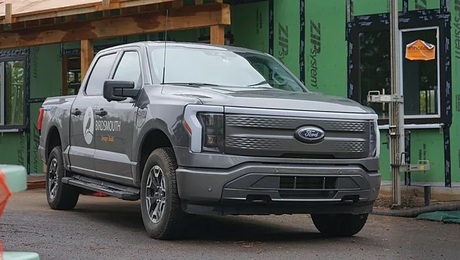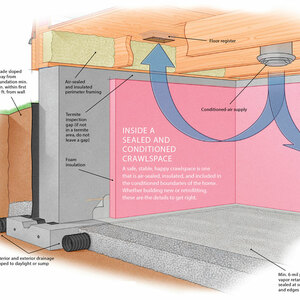I did an exposed aggregate wall. I had some problems with over exposure because of the way I had to pour it as the truck couldn’t get in all the way so it meant a lot of moving the mud down the wall. I think the retarder got washed off in spots and must of moved to a higher concentration in certian areas?? Anyway to make a long story short I wonder if anyone has experience with these kind of pours. Is it acceptable to use a vibrator, or will that cause the rock to go in to far so you can’t expose it very well?
Discussion Forum
Discussion Forum
Up Next
Video Shorts
Featured Story

Ford Motor Company slashes prices for some F-150 Lightning models to stimulate demand for electric vehicles (EVs).
Highlights
"I have learned so much thanks to the searchable articles on the FHB website. I can confidently say that I expect to be a life-long subscriber." - M.K.

















Replies
For what it's worth, there's a method called tilt slab or tilt up, which is the best way to get the aggregate exposure desired.
Basically, the wall is formed on a level slab with a sheet of poly underneath. Then the exposed aggregate is laid down, before pouring the wall as a slab. After the wall has cured sufficiently, it's tilted up into place.
Try Google for full description of that process.
Another method in tilt up is to pour the wall flat, and then tamp in additional aggregate on the exposed surface. When it is set up enough to broom finish you wet it down with the hose, and start brushing off the paste, and flushing with the hose until you have exposed the aggregate.
Now that you clarify it, I'll admit that my memory is probably inaccurate. I never worked on a tilt slab but I worked for a contractor who did a few, back in '81.
What you say makes more sense, considering that the walls were poured in position, ready to raise after they cured. That would require that the aggregate exterior be on top.
I'd try it the other way too, if that method made it possible to accomplish my ends. But I'd do a small experimental section first, to determine what would work regarding the slump, etc.
the aggregate on the bottom because you lift from the top, the inside plane
I've seen them both ways. I've seen precast panels that looked like hand laid stone, done by laying out the stone in a sand bed, then wetting the sand just before placing the concrete over it. After curing, the slab was then lifted, and the sand washed out. Then the gaps between the stone were pointed with mortar. Putting an exposed aggregate finish on the top surface works well, because you can see what the surface will look like as you scrub out the paste. Plus, when you are adding aggregates to the surface, by broadcasting and tamping, you can use things like polished/smooth river rock, and glass, that would decrease the strength/longevity if they were distributed through out the concrete in sufficient quantity to get the finished effect you want. You can combine the two methods by casting over form liners, to end up with precast panels that have two finished faces. Cast in a foam inner core, and you have a really efficient precast exterior wall.
Perhaps I should clairify my project a little. The wall was actually a foundation for a deck. Now I am buildings a concrete landing and stairs where the sides of the landing (ie 2 sides) and the stairs are exposed aggregate and the top of the landing and the stair will be a broom finish. So I need want to make sure I get as even of an exposure as possible.
Thanks, that's very interesting, both techniques.
vibrator is fine
Sorry about stealing your thread.
Yes, you should vibrate the wall, particularly if it is going to be exposed. You definitely don't want rock pockets or honeycombing to show. The vibration is intended to consolidate the mud, and get the air out. Any segregation is more likely to have been caused by moving the mud with the vibrator, over vibration, or poor placement, such as dropping to far into the forms.
For these kind of placements it is probably best to bid in the cost of a pump truck, rather than trying to depend on getting the mix trucks close enough to chute it in. Pushing the mud along the wall, may have removed the retarder, in spots, and left high concentrations at other places.
Ideally: You want to place the mud right where you want it; Vibrate it for consolidation; And, avoid movement of the mud in the forms if you can.
A pump, while not essential for this, is highly desirable. With the pump you can place mud on the side of the form that isn't going to have the exposed aggregate, and let it slide down that form wall, with out abrading the retarder off the wall you want the exposed aggregate on. Depending on the maximum aggregate size, the hose on the pump can be reduced in size to make accurate placement in your forms easier. Talk to the pump company when you are making your arrangements, and they can probably help you out.
If you are trying to do exposed aggregate on both faces, you might want to actually thicken the wall slightly, put in two mats of rebar, and pump the mud between the mats to minimize flow along the forms.
Thanks for the advice. I have used pumper trucks before but this was only a 3 yard pour so it was hardly cost effective. I had just never done exposed aggregate this way and I think that it was a problem of over concentration of retarder in areas. So I"ll try to place it better and use a vibrator a little. I guess as the saying goes, "live and learn."
If you are chuting it a trimmy might help.
What's a "trimmy"?
its a chute or sock that you feed to the bottom of the form, like a fabric funnel for the concrete to slide down. Its suppose to stop segregation of the aggregate.